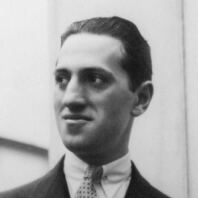George Gershwin
Compositeur
George Gershwin lived the American dream of the “self-made man”: with his successful musical comedies, he worked his way up from humble beginnings to become an acclaimed Broadway star. He landed his first big hit in 1918 with the song Swanee. Gershwin’s works, which were an idealised representation of the American concept of the “modern way of life”, were soon being played in concert halls – without the composer ever having attended a conservatory.
George Gershwin was born in 1898 in Brooklyn, New York, the son of Russian-Jewish immigrants. As a child, he heard Anton Rubinstein’s Melody in F from a music automaton: “I can no longer hear this melody without seeing myself standing on 125th Street, barefoot, in cotton trousers, and eagerly drinking in this music”. Gershwin was inspired. At the piano of a fellow pupil, he playfully tried to imitate what he heard on the streets. It was not until he was twelve years old that his parents bought him an instrument – actually for his brother Ira, who later became his closest collaborator as a songwriter. Gershwin received piano and music theory lessons, although it is not known for how long. In May 1914, he gave up his training at the High School of Commerce, which he had pursued with little enthusiasm, to take up a position as a demonstration pianist with the publishing house Jerome H. Remick & Company. It was located on the section of Manhattan’s 28th Street known as Tin Pan Alley, which was the centre of the popular music industry at the time. Gershwin joined the Broadway show Miss 1917 as a rehearsal pianist, where he made important contacts. In the meantime, his own songs were becoming increasingly successful. His Rhapsody in Blue, which the bandleader Paul Whiteman had skilfully presented as an “experiment in modern music”, brought him a triumph at its premiere in New York’s Aeolian Hall in 1924. The premiere of Porgy and Bess marked Gershwin’s final breakthrough as a “classical” composer – two years before he died at the age of 38 from a brain tumour that was detected too late.